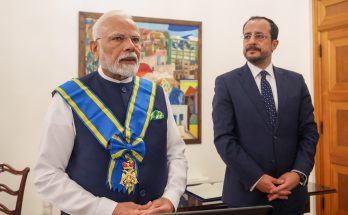By Lt. Gen. (Retd.) Raj Shukla
Operation Sindoor marks a paradigm shift from the policy of ‘strategic restraint,’ that hitherto marked India’s response to Pakistan-sponsored terror, to a calibrated, offensive poise. The operation has underscored the utilitarian use of conventional force and has called Pakistan’s schoolboy bluff on terror, writes Raj Shukla
 “Operation Sindoor,” by any reckoning, has been an overwhelming strategic-military success. Its most significant outcome has been that India has re-discovered the utility of force. To understand the import of the significant transition, we need to hark back to the decades of ‘strategic restraint[i]:’ the hallmark of our statecraft for a while, particularly against acts of terror. I refer to the politico-military inaction, post the Parliament Attack (Dec 2001), the Kaluchak Massacre (in May 2002) as also in the aftermath of the gruesome terror attacks in Mumbai in 2008 (26/11), all under the rubric of ‘strategic restraint.’ In the fullness of time, such strategic restraint became a matter of highbrow theorising; this attribute also seeped into India’s armed forces, putting a question on the very utility of force in the subcontinent.
“Operation Sindoor,” by any reckoning, has been an overwhelming strategic-military success. Its most significant outcome has been that India has re-discovered the utility of force. To understand the import of the significant transition, we need to hark back to the decades of ‘strategic restraint[i]:’ the hallmark of our statecraft for a while, particularly against acts of terror. I refer to the politico-military inaction, post the Parliament Attack (Dec 2001), the Kaluchak Massacre (in May 2002) as also in the aftermath of the gruesome terror attacks in Mumbai in 2008 (26/11), all under the rubric of ‘strategic restraint.’ In the fullness of time, such strategic restraint became a matter of highbrow theorising; this attribute also seeped into India’s armed forces, putting a question on the very utility of force in the subcontinent.
When applied in concert with the Pakistani schoolboy nuclear bluff, it very nearly paralysed Indian statecraft. In consequence, terror emerged as this low-cost, high-productivity option in the quiver of Pakistan’s strategic toolkit. Under the cover of a nuclear rattle, Pakistan went on a virtual terror rampage, a strategy against which India fumbled to find a reasonable response.
Offensive Poise
That ‘strategic restraint,’ has now given way to a finessed, calibrated, offensive poise. Let me recall the despondent mood of those earlier times, if only to put the new-found ‘offensive poise’ in perspective. Eminent journalist Arun Shourie reflected the anguish of those times when he said, “not an eye for an eye, not a tooth for a tooth, for an eye both the eyes, for a tooth the whole jaw.[ii]” Another leading figure mocked the instrument of force. “Aap ki joh air force hai,” he said, “yeh Gwalior se take off karti hai, aur bina dushman par hamla kiye, zoon-zoon kar ke, Ambala mein land kar jaati hai.” (Your Air Force takes off from Gwalior, and without hitting the enemy, lands in Ambala). Super cop K.P.S Gill, who led the counter terror campaign in Punjab, offered some sane advice, “You will not win the war on terror,” he said,” merely, by chasing terrorists; you will win it by overwhelming the adversary.”
Operation Sindoor has converted the mood, despair, frustration, even wisdom of those times, into a new strategic reality.
 By underscoring the utilitarian use of conventional force, India has called Pakistan’s schoolboy bluff on terror. Terror is no longer a low-cost option for Pakistan[iii]. It has to make a choice; should it continue to meddle in the terror bazaar and should such nursing manifest into acts of terror on Indian soil, Pakistan will face the retribution of India’s military might. That is the strategic knot that the Pakistanis have tied around themselves.
By underscoring the utilitarian use of conventional force, India has called Pakistan’s schoolboy bluff on terror. Terror is no longer a low-cost option for Pakistan[iii]. It has to make a choice; should it continue to meddle in the terror bazaar and should such nursing manifest into acts of terror on Indian soil, Pakistan will face the retribution of India’s military might. That is the strategic knot that the Pakistanis have tied around themselves.
Military Metrics
How did the military metrics of Operation Sindoor unfold?
Apart from the first night (May 6/7), a night on which a fierce battle in long-range air combat unfolded, despite a brief BVR stalemate (a system of aerial sensors and shooters that enable beyond visual range engagements), India managed to penetrate Pakistan’s air defence system and strike the heart of Pakistan’s terror ecosystem in Pakistani Punjab – Muridke, Bahawalpur, Rawalpindi and Raiwind. This was unprecedented. Pakistan was concurrently offered an off-ramp that it chose to decline.
In the exchanges that ensued, through astute management of the escalatory ladder, India retained operational dominance throughout. Even as India’s AD Wall held strong (the integrated enterprise of the S-400, Akashteer, L-70s, Schilkas, et al, were robust and resilient), in sharp contrast, Pakistan’s AD systems were overwhelmed by the delightful synchrony of a wide array of precision systems – Scalp, Hammer, Halop, Brahmos and Excalibur strikes. The manner in which Pakistan’s AD including the much-hyped HQ-9 crumbled was indeed shocking; the Chinese J-10s and /J-17s far from being employed in attack sorties, were scurrying for cover.
The strikes on the air bases from Skardu to Bholari to include Nur Khan, Rafiqi, RYK, Sargodha and Murid, not only took out F-16s, Drone HQs, a C-130, a Saab AWACS system and other high value aerial assets, they struck terror across the length and breadth of Pakistan. Jinnah’s Pakistan lay naked – exposed and vulnerable, its air infrastructure degraded beyond 20%, its much- hyped Fizaya (Pak AF) barely in a position to fly, let alone mount combat missions. So, penetrating and devastating were the Indian strikes, that a war of words and intense blame gaming broke out between the Pakistan Army and its Air Force. The Indian Navy’s strong domineering posture went virtually unchallenged, it was held back; had it been unleashed, Asim Munir would have had no place to hide. Even his phoney elevation to Field Marshal may not have been able to bail him out. So complete was the military decimation, that it may not be an exaggeration to say that Munir’s two-nation theory and its terror progeny were buried once again, this time in the Arabian Sea.
5 National Security Pathways
While celebrations are in order, “Operation Sindoor” is also a time for some serious introspection, a strategic-military review so to speak, in order to brace up for the national security challenges of the future – terror and associated military crisis along our western and eastern horizons, military manifestations of bigger power competition along our northern borders and the oceanic frontiers to the south. What are the deterrence pathways that we must create in order that we do not have to war fight either with Pakistan or with China? Not episodic resourcing to get over the immediate crisis, but the development of enduring, deeper, technologically chiselled, strategic-military capacities.
So here are five pathways, that we may like to work upon.
First and foremost, we must revisit the metrics of our economic statecraft.
- Given India’s very adverse threat environment, we need to revisit the metrics of defence spending. The country’s very gifted economists will have to find the ways, means and more importantly, the money that we need for deterrence. May I also say that ‘guns versus growth’ is a puerile argument. On the contrary, spending on indigenous defence technology boosts the economy. Defence provides jobs, it generates revenues for the state and boost exports.
- In fact, a recent paper in the American Economic Review argued that military spending has a fiscal multiplier of nearly 2; a rupee spent on military spending sensibly, creates an additional GDP of another rupee. More importantly, the additional rupee comes with enhanced productivity that endures. So, defence spending helps to pump prime the economy.
Two, we need to fuel a technological renaissance.
While some baby steps have been taken here and there, what we need is a veritable technological renaissance, if India is to get to the next level of economic productivity and strategic poise. Of what kind? In what manner? This piece of data may be useful. In the years 2003-2007, across the gamut of emerging, critical, technologies – AI, quantum, robotics, biotech, and the like – the US, the world’s sole superpower, led in 60 out of 65 technologies. Then, China launched its Thousand Talents Plan, developed a diaspora strategy and today, China leads in 57 out of 65 critical, emerging, technologies. What a dramatic inversion in technology leadership!
The good news is that in at least some ten of these sub-sets, India is not too far behind – in fact, a distant third. So, could we not pick these ten subsets and through laser-focussed resolve, in ten years, emerge as the world’s leader in at least ten emerging technologies, laying, in the process, the edifice for a larger technological reconnaissance. We need to act fast – else, our very technological sovereignty may be at risk.
Three, we need to embrace innovation and boost R&D.
- The high ground of strategic-military futures is technological innovation. In Ukraine, the best performers are not government behemoths like NASA, nor traditional defence primes like Boeing or Lockheed, but agile, fleet-footed, innovative start-ups like Starlinks, Palantir and Anduril.
- Ukraine, a country without a navy has used crude drones and Elon Musk’s Starlinks to knock out Russia’s formidable Black Sea fleet out of the naval base in Sevastopol.
- Palantir’s AI-enabled data services have quickened the pace of military decision- making, reduced target engagement cycles – artillery shoots which once took as long as 30 minutes are now concluded with surgical precision in less than five, while also helping to develop the art and science of drones. Drones penetrate trenches, they get through tank turrets and are also used as strategic airpower – to degrade adversary energy and infrastructural grids.
- Quite unsurprisingly, 80% of Russian casualties in men and equipment have been caused, not by adversary artillery, armour, or airpower, but by 100-dollar Ukrainian drones and the skilful marriage of micro-electronics and explosives.
- India’s strategic-military sector needs its own Silicon Valley – a zone that bustles with energy, enterprise, and cradles of defence innovation. That the designated defence corridors around Lucknow and Chennai are being dotted more by traditional defence public sector units (PSUs) and that the footprint of the private sector and start-ups is not sufficiently large, is not a good omen. The trend needs to be corrected urgently and surgically.
Research and Development
The US spends $823 billion annually on R&D in science[iv], of which a whopping 600 billion dollars come from the private sector. The Indian private sector may like to take inspiration.
- China spends $781 billion dollars annually on R&D in science. No wonder Jensen Huang, the CEO of Nvidia, describes Chinese researchers in AI as ‘world-class’[v].
- India’s spend on R&D is a woeful $40 billion, with the contributions of the private sector being abysmally meagre.
- The moot point is not why is our spend on R&D so low, the real question is as to why neither the Indian government, nor the private sector see obvious value in R&D?
- Inadequacies in R&D will translate directly into feeble strategic-military futures.
Four, we need a major cultural transition, namely the clinical embrace of Civil-Military fusion.
Civil-military fusion is a concept which originated in China and is driven personally by President Xi himself. Why build walls of granite between civil and military cylinders of excellence,’ he asks. It has been used by the Chinese very craftily for more efficient delivery and to prevail in the strategic-military competition; to upturn with great guile, specifically, the obsession of Western democracies with the concept of dual-use protocols that prevent civilian technologies from being leveraged for military use.
China’s prowess in shipbuilding, which has powered both global commerce and a global navy as also its proficiencies in chips, are driven by the secret sauce of CMF. It is also being used to pilot the growth of AI. The Chinese argue that controls in the civilian domain of AI need to be overwhelming, perhaps to enable state surveillance of its citizenry: but they are categorical that in the strategic-military domain of AI, for reasons of national interest the approach will be freewheeling, allowing strategic-military applications in AI to progress with abandon.
In a similar vein, we in India too, need to collapse all silos – civil, military, government, private sector, academia, the corporates, and the start-up eco-system. Talents and attributes from diverse domains need to come together and fuse in pursuit of national security endeavours. Cross- pollination of ministries and structures will have to be the new norm.
We need to embrace the concept of “National Champions” in defence, with a strategic focus, like much of the world does. Defence provides budding start-ups with initial orders; it holds their hand till commercial viability; and the particularly talented start-ups are assisted further to destroy adversary competition. So, a lot of strategic hand holding till the start-ups are thrown into the brutal, global markets. And those identified as National Champions continue to be assisted for ever, in the resolute pursuit of national interest.
Five, we need to laser focus on some critical capacity-building initiatives.
Stealth-enabled offensive airpower – stealth is a necessary accretion to our air inventory, if we are to break out of the BVR impasse and penetrate adversary air defences. Drone Missile Force – an adroit mix of drones, FPVs, loiter munitions, ballistic and cruise missiles, with a formal structure and leadership system to complement stealth enabled, offensive airpower.
AD Topology – while our AD has been resilient against the Pakistan offensive, it may not be adequate to withstand an onslaught from a far more sophisticated PLA Rocket Force. A major topological transformation in AD is an imperative.
The Long View
As the world’s fourth largest economy, the Lowy Asian Power Index ranks us as the third most powerful country in the world. India is now a formidable middle power – an aspiring Vishwabandhu, (brother of the world), navigating its rise through some complex power play between a contested hegemon, the USA, and a rising challenger, China. Now that we are entering the big league, we will also have to step up our game in national security in terms of taking a long view, in terms of sophistication and deliverance.
Operation Sindoor may well be the much-needed catalyst in the endeavour – in that sense it is a seminal moment in Indian statecraft.
(Lieutenant General Raj Shukla is Member, UPSC, and a retired General Officer of the Indian Army who served as the General Officer Commanding-in-Chief of the Army Training Command. He served two tenures at the Military Operations Directorate dealing with Doctrines / Force Structuring and was the Director General, Perspective Planning, addressing issues relating to Military Futures and Force Modernisation. He has also been Commandant of the Indian Army’s prestigious training establishment and think tank – the Army War College. In recognition of his service of the most exceptional order, he was awarded the Param Vishisht Seva Medal on Republic Day 2021. )
References
i] Former Defence Minister, Jaswant Singh, ‘the most taxing challenge …was to get Indian Military Chiefs to recognise restraint as a strategic asset for avoiding conflict.” Gen NC Vij, Alone In The Ring – Decision Making In Critical Times, Bloomsbury India, 2025
. [ii] Jaw for tooth, Arun spits fire – Telegraph India, Arun Shourie, Jaw for Tooth – Arun Spits Fire, The Telegraph. 11 Dec 2008
[iii] Pakistan will pay increasingly higher price for backing terror: Shashi Tharoor | Latest News India – Hindustan Times, Rezaul H. Laskar, Hindustan Times, 25 May 2025
[iv] China Is Catching Up in R&D—And May Have Already Pulled Ahead | ITIF, Trelysa Long. Information Technology & Innovation Foundation, 09 April 2025
[v] Nvidia’s Jensen Huang praises China’s AI talent, warns US against restrictive chip rules, Business Today. 29 May 2025
Author Profile
- India Writes Network (www.indiawrites.org) is an emerging think tank and a media-publishing company focused on international affairs & the India Story. Centre for Global India Insights is the research arm of India Writes Network. To subscribe to India and the World, write to editor@indiawrites.org. A venture of TGII Media Private Limited, a leading media, publishing and consultancy company, IWN has carved a niche for balanced and exhaustive reporting and analysis of international affairs. Eminent personalities, politicians, diplomats, authors, strategy gurus and news-makers have contributed to India Writes Network, as also “India and the World,” a magazine focused on global affairs.
Latest entries
 India and the WorldJune 26, 2025Operation Sindoor: India Sheds Restraint, Rediscovers Utility of Force
India and the WorldJune 26, 2025Operation Sindoor: India Sheds Restraint, Rediscovers Utility of Force India and the WorldJune 23, 2025BRICS summit in Rio to focus on Global South, local currency trade
India and the WorldJune 23, 2025BRICS summit in Rio to focus on Global South, local currency trade Africa InsightsJune 11, 2025New Opportunities in India-Japan Cooperation in Africa
Africa InsightsJune 11, 2025New Opportunities in India-Japan Cooperation in Africa India and the WorldMay 23, 2025Post-Operation Sindoor, India reminds Turkey, China of concerns and sensitivities
India and the WorldMay 23, 2025Post-Operation Sindoor, India reminds Turkey, China of concerns and sensitivities








